Influence of Project Governance Mechanisms on the Sustainable Development of Public-Private Partnership Projects: An Empirical Study from China
Abstract
:1. Introduction
- RQ1:
- How does the PPP project governance mechanism influence project governance performance and project sustainability?
- RQ2:
- What is the interaction between the contract governance mechanism, relational governance mechanism and risk governance mechanism?
2. Conceptual Model and Research Hypotheses
2.1. The Establishment of a Conceptual Model
2.2. Governance Mechanism and PPP Project Governance Performance under the Direct Effect
2.3. Three Types of Governance Mechanism and PPP Project Governance Performance
2.4. Governance Mechanism and PPP Project Governance Performance under the Mediating Effect
2.5. Governance Performance and PPP Project Sustainability
2.6. List of Hypotheses
3. Research Methods and Data Collection
3.1. Research Methods
3.2. Data Collection
4. Model Quality Assessment
4.1. Reliability and Validity Tests
4.2. Goodness of Fit Testing
5. Hypotheses Testing
5.1. Direct Effect Testing
5.2. Mediating Effect Testing
Test Results of Mediating Effect Testing
6. Discussion
6.1. Mechanism of the Governance Mechanism Acting on the Sustainability of PPP Projects
6.2. Optimization Strategy for PPP Project Governance Mechanisms
7. Conclusions
Author Contributions
Funding
Data Availability Statement
Conflicts of Interest
References
- Asian Development Bank. Public-Private Partnership (PPP) Handbook; Asian Development Bank: Mandaluyong, Philippines, 2008; pp. 1–2. [Google Scholar]
- Ye, X.; Shi, S.; Chong, H.-Y.; Fu, X.; Liu, L.; He, Q. Empirical analysis of firms’ willingness to participate in infrastructure PPP projects. J. Constr. Eng. Manag. 2018, 144, 04017092. [Google Scholar] [CrossRef]
- Li, K.M. PPP mode innovation and sustainable development path selection. Bidding Procure. Manag. 2018, 70, 45–51. [Google Scholar]
- Nations, U. Transforming Our World: The 2030 Agenda for Sustainable Development. 2015. Available online: https://sustainabledevelopment.un.org/post2015/transformingourworld/publication (accessed on 23 January 2023.).
- Yang, L. Analysis and Countermeasures of the problems in the development of PPP projects in China. China’s Collect. Collect. Economy 2017, 14, 18–19. [Google Scholar]
- Shen, L.; Tam, V.; Gan, L.; Ye, K.; Zhao, Z. Improving sustainability performance for Public-Private-Partnership (PPP) projects. Sustainability 2016, 8, 289. [Google Scholar] [CrossRef]
- Abednego, M.P.; Ogunlana, S.O. Good project governance for proper risk allocation in public-private partnerships in Indonesia. Int. J. Proj. Manag. 2006, 24, 622–634. [Google Scholar] [CrossRef]
- Xiong, W. Theory and practice of sustainable development-oriented PPP model. J. Tongji Univ. Soc. Sci. Ed. 2017, 28, 78–84. [Google Scholar]
- Babatunde, S.O.; Ekundayo, D.; Udeaja, C.; Abubakar, U.O. An Investigation into the Sustainability Practices in PPP Infrastructure Projects: A Case of Nigeria. Smart and Sustainable Built Environment. 2020. Available online: https://www.emerald.com/insight/2046-6099.htm (accessed on 23 January 2023.).
- Hueskes, M.; Verhoest, K.; Block, T. Governing public-private partnerships for sustainability an analysis of procurement and governance practices of PPP infrastructure projects. Int. J. Proj. Manag. 2017, 35, 1184–1195. [Google Scholar] [CrossRef]
- Wang, N.; Ma, M. Public–private partnership as a tool for sustainable development-what literatures say? Sustain. Dev. 2020, 29, 243–258. [Google Scholar] [CrossRef]
- Kong, Z.; Ma, H.; Lv, K.; Shi, J.J. Liability of Foreignness in Public-Private Partnership Projects. J. Constr. Eng. Manag. 2023, 149, 04023085. [Google Scholar] [CrossRef]
- Gu, Q.; Yang, W.H.; Dai, D.S. Theoretical research and progress review of project governance. Build. Econ. 2012, 2, 64–67. [Google Scholar]
- Hurk, M.V.D.; Verhoest, K. The challenge of using standard contracts in public-private partnerships. Public Manag. Rev. 2016, 18, 278–299. [Google Scholar] [CrossRef]
- Henisz, W.J.; Levitt, R.E.; Scott, W.R. Toward a unified theory of project governance: Economic, sociological and psychological supports for relational contracting. Eng. Proj. Organ. J. 2012, 2, 37–55. [Google Scholar] [CrossRef]
- Cao, Z.; Lumineau, F. Revisiting the interplay between contractual and relational governance: A qualitative and meta-analytic investigation. J. Oper. Manag. 2015, 33–34, 15–42. [Google Scholar] [CrossRef]
- Xue, J.; Yuan, H.; Shi, B. Impact of contextual variables on effectiveness of partnership governance mechanisms in megaprojects: Case of Guanxi. J. Manag. Eng. 2017, 33, 04016034. [Google Scholar] [CrossRef]
- Zhang, W.K.; Yang, Y.H.; Wang, Y.Q. Key determinants of public-private partnership performance—Based on empirical research in several transition countries. J. Public Adm. 2010, 3, 103–112+127–128. [Google Scholar]
- Qi, X.; Ke, Y.J.; Wang, S.Q. Case—Based analysis of major risk factors for PPP projects in China. Soft Sci. China 2009, 5, 107–113. [Google Scholar]
- Yuan, J.F. Risk assessment of residual value of infrastructure PPP projects based on SEM. Tech. Econ. 2013, 1, 75–84. [Google Scholar]
- Sun, J.; Shi, Y.F. From the perspective of social network analysis, Research on the governance mechanism and relationship between PPP projects and its elements. Seek. Truth 2021, 5, 36–49. [Google Scholar]
- Warsen, R.; Klijn, E.H.; Koppenjan, J. Mix and match: How contractual and relational conditions are combined in successful Public–Private Partnerships. J. Public Adm. Res. Theory 2019, 29, 375–393. [Google Scholar] [CrossRef]
- Chen, L.; Manley, K. Validation of an instrument to measure governance and performance on collaborative infrastructure projects. J. Constr. Eng. Manag. 2014, 5, 63–70. [Google Scholar] [CrossRef]
- Lu, P.; Guo, S.; Qian, L. The effectiveness of contractual and relational governances in construction projects in China. Int. J. Proj. Manag. 2015, 1, 212–222. [Google Scholar] [CrossRef]
- Zhang, H.; Shi, S.; Zhao, F.; Ye, X.; Qi, H. A Study on the Impact of Team Interdependence on Cooperative Performance in Public–Private Partnership Projects: The Moderating Effect of Government Equity Participation. Sustainability 2023, 15, 12684. [Google Scholar] [CrossRef]
- Zhou, Z.X.; Zhang, X.P.; Zhang, P. Problems and countermeasures in the application of PPP mode under the new normal. Soft Sci. China 2015, 9, 82–95. [Google Scholar]
- Williamson, O.E. Transaction-Cost Encomics: The Governance of Contractual Relations. J. Law Econ. 1979, 22, 233–261. [Google Scholar] [CrossRef]
- Schepker, D.J.; Ohw, Y.; Martynov, A. The Many Futures of Contracts: Moving Beyond Structure and Safeguarding to Coordination and Adaptation. J. Manag. Off. J. South. Manag. Assoc. 2014, 40, 193–225. [Google Scholar] [CrossRef]
- Lee, Y.; Cavusgil, S.T. Enhancing alliance performance: The effects of contractual-based versus relational-based governance. J. Bus. Res. 2006, 59, 896–905. [Google Scholar] [CrossRef]
- Yan, L.; Zhang, L. Interplay of contractual governance and trust in improving construction project performance: Dynamic perspective. J. Manag. Eng. 2020, 36, 04020029. [Google Scholar] [CrossRef]
- Yan, L.; Deng, X.W.; Deng, J.J. Empirical research on agent incentives based on key project governance factors: Taking project control rights as moderating variables. J. Civ. Eng. 2014, 6, 126–137. [Google Scholar]
- Ferguson, R.J.; Paulin, M.; Bergeron, J. Contractual governance, relational governance, and the performance of interfirm service exchanges: The influence of boundary-spanner closeness. J. Acad. Mark. Sci. 2005, 2, 217–234. [Google Scholar] [CrossRef]
- Lewis, M.; Roehrich, J. Towards a Model of Governance in Complex (Product-Service) Inter-Organisational Systems; Social Science Electronic Publishing: Kiel, Germany, 2017. [Google Scholar]
- Williamson, O.E.; Duan, Y. Capitalist Economic System: On Enterprise Contract and Market Contract; The Commercial Press: Shanghai, China, 2004. [Google Scholar]
- Joyner, K. Dynamic evolution in public private partnerships. Manag. Law 2007, 49, 206–217. [Google Scholar]
- Liang, Y.K. Contract Governance and Relationship Governance in Project Management; Sun Yat-Sen University: Guangzhou, China, 2008. [Google Scholar]
- Cheung, S.O.; Yiu, T.W.; Lam, M.C. Interweaving Trust and Communication with Project Performance. J. Constr. Eng. Manag. 2013, 139, 941–950. [Google Scholar] [CrossRef]
- Xie, H.T.; Chen, F. Research on the influence of contract governance and relationship governance on construction project performance. Proj. Manag. Tech. 2013, 11, 14–18. [Google Scholar]
- Xiang, P.; Zhou, J.; Zhou, X.; Ye, K. Construction Project Risk Management Based on the View of Asymmetric Information. J. Constr. Eng. Manag. 2012, 138, 1303–1311. [Google Scholar] [CrossRef]
- Lau, E.; Rowlinson, S. Trust relations in the construction industry. Int. J. Manag. Proj. Bus. 2010, 3, 693–704. [Google Scholar] [CrossRef]
- Li, X.G. A Study on the Alocation of PPP Project Control Right-Based on Relationship Governance and Contract Governance. Ph.D. Thesis, Beijing Jiaotong University, Beijing, China, 2019. [Google Scholar]
- Wang, D.; Fang, S.; Li, K. Dynamic changes of governance mechanisms in mega construction projects in China. Engineering. Constr. Archit. Manag. 2019, 26, 723–735. [Google Scholar] [CrossRef]
- Wong, W.K.; Cheung, S.O.; Yiu, T.W.; Pang, H.Y. A framework for trust in construction contracting. Int. J. Proj. Manag. 2008, 26, 821–829. [Google Scholar] [CrossRef]
- Larson, E. Project partnering: Results of study of 280 construction projects. J. Manag. Eng. 1900, 2, 30. [Google Scholar] [CrossRef]
- Yin, Y.L.; Xu, Z.C. The relationship between trust, cooperation and project management performance in engineering projects: From the perspective of relational governance. J. Beijing Inst. Technol. Soc. Sci. Ed. 2014, 16, 41–51. [Google Scholar]
- Luo, L.; Hu, Y.D.; Luo, Q. Research on the relationship between project governance and project performance based on meta-analysis. Build. Econ. 2021, 42, 290–295. [Google Scholar]
- Sun, Y.G. Research on the Performance of PPP Project Governance Based on the Dual Governance of Contractual Relations. Ph.D. Thesis, Beijing Jiaotong University, Beijing, China, 2021. [Google Scholar]
- Ness, H.; Haugland, S.A. The evolution of governance mechanisms and negotiation strategies infixed-duration interfirm relationships. J. Bus. Res. 2005, 12, 26–39. [Google Scholar]
- Wang, W.X.; Li, Q.M. Risk early warning model of private party in infrastructure project under PPP mode. J. Chongqing Jianzhu Univ. 2008, 5, 90–94. [Google Scholar]
- Liu, R.K.; Liu, X.Z.; Rong, M. Research on risk rating method of government investment project governance. Soft Sci. 2011, 25, 29–35. [Google Scholar]
- You, Y.B. Research on PPP Infrastructure Project Governance Risk Hua Zhong University of Science and Technology. Master’s Thesis, Huazhong University of Science and Technology, Wuhan, China, 2016. [Google Scholar]
- Feng, L. Research on the Current Situation and Countermeasures of PPP Model Risk Management Based on SWOT Perspective. Master’s Thesis, Zhengzhou University, Zhengzhou, China, 2016. [Google Scholar]
- Zhang, N.; Ding, R.G. Research on risk assessment based on Unified framework of project governance. Prog. Sci. Technol. Countermeas. 2014, 31, 84–88. [Google Scholar]
- Hällgren, M.; Wilson, T.L. The Nature and Management of Crises in Construction Projects: Projects-as-practice Obser-vations. Int. J. Proj. Manag. 2008, 26, 231–246. [Google Scholar] [CrossRef]
- Xing, H.G.; Wu, B. Review of PPP project risk assessment: Based on Cite Space Visual analysis. Build. Econ. 2022, 43, S1. [Google Scholar]
- Poppo, L.; Zenger, T. Do Formal Contracts and Relational Governance Function as Substitutes or Complements. Strateg. Manag. J. 2002, 23, 707–725. [Google Scholar] [CrossRef]
- Yuan, J.; Zhang, L.; Tan, Y.; Skibniewski, M.J. Evaluating the regional social sustainability contribution of public-private partnerships in China: The development of an indicator system. Sustain. Dev. 2019, 28, 259–278. [Google Scholar] [CrossRef]
- Abdelfattah, F. Relation between Green Buildings and Sustainable Development Practices. In 1st International Conference: Towards A Better Quality of Life. 2017. Available online: https://papers.ssrn.com/sol3/papers.cfm.abstract_id53163476 (accessed on 30 January 2023).
- Maslova, S. Achieving sustainable development goals through public private partnership: Critical review and prospects. Int. J. Innov. Sustain. Dev. 2020, 14, 288–312. [Google Scholar] [CrossRef]
- Xiong, W.; Chen, B.; Wang, H.; Zhu, D. Public–private partnerships as a governance response to sustainable urbanization: Lessons from China. Habitat Int. 2020, 95, 102095. [Google Scholar] [CrossRef]
- Cheng, M.; Liu, G.; Xu, Y. Can joint-contract functions promote PPP project sustainability performance? A moderated mediation model. Eng. Eng. Constr. Archit. Manag. 2021, 28, 2667–2689. [Google Scholar] [CrossRef]
- Cheng, Z.; Wang, H.; Xiong, W.; Zhu, D.; Cheng, L. Public–private partnership as a driver of sustainable development: Toward a conceptual framework of sustainability-oriented P Environment. Dev. Sustain. 2020, 23, 1043–1063. [Google Scholar] [CrossRef]
- Wang, H.; Zhang, X.; Lu, W. Improving social sustainability in construction: Conceptual framework based on social network analysis. J. Manag. Eng. 2018, 34, 05018012. [Google Scholar] [CrossRef]
- Wang, T.Y. Sustainable Development Goals and PPP Standards from a global perspective: China’s choice. REFORM 2016, 264, 20–34. [Google Scholar]
- Koppenjan, J.F.M. Public–Private Partnerships for green infrastructures. Tensions and challenges. Curr. Opin. Environ. Sustain. 2015, 12, 30–34. [Google Scholar] [CrossRef]
- Mohammed Abdelkader, E.; Zayed, T.; El Fathali, H.; Alfalah, G.; Al-Sakkaf, A.; Moselhi, O. An Integrated Multi Criteria Decision Making Model for the Assessment of Public Private Partnerships in Transportation Projects. Mathematics 2023, 11, 3559. [Google Scholar] [CrossRef]
- Yan, L.; Shi, Z.C.; Yan, M. Contract Governance and relational Governance in public projects: Alternative or complementary? Civ. Eng. 2016, 11, 115–128. [Google Scholar]
- Mohr, J.; Spekman, R. Characteristics of partnership success: Partnership attributes, communication behavior, and conflict resolution techniques. Strateg. Manag. J. 1994, 15, 135–152. [Google Scholar] [CrossRef]
- Renn, O.; Klinke, A.; Van Asselt, M. Coping with Complexity, Uncertainty and Ambiguity in Risk governance: A Synthesis. AMBIO 2011, 40, 231–246. [Google Scholar] [CrossRef]
- She, L.; Tang, S. Research on the Performance Evaluation of the Contract Governance in the PPP Mode Based on AHP. Int. Conf. Constr. Real Estate Manag. 2017, 2017, 309–317. [Google Scholar]
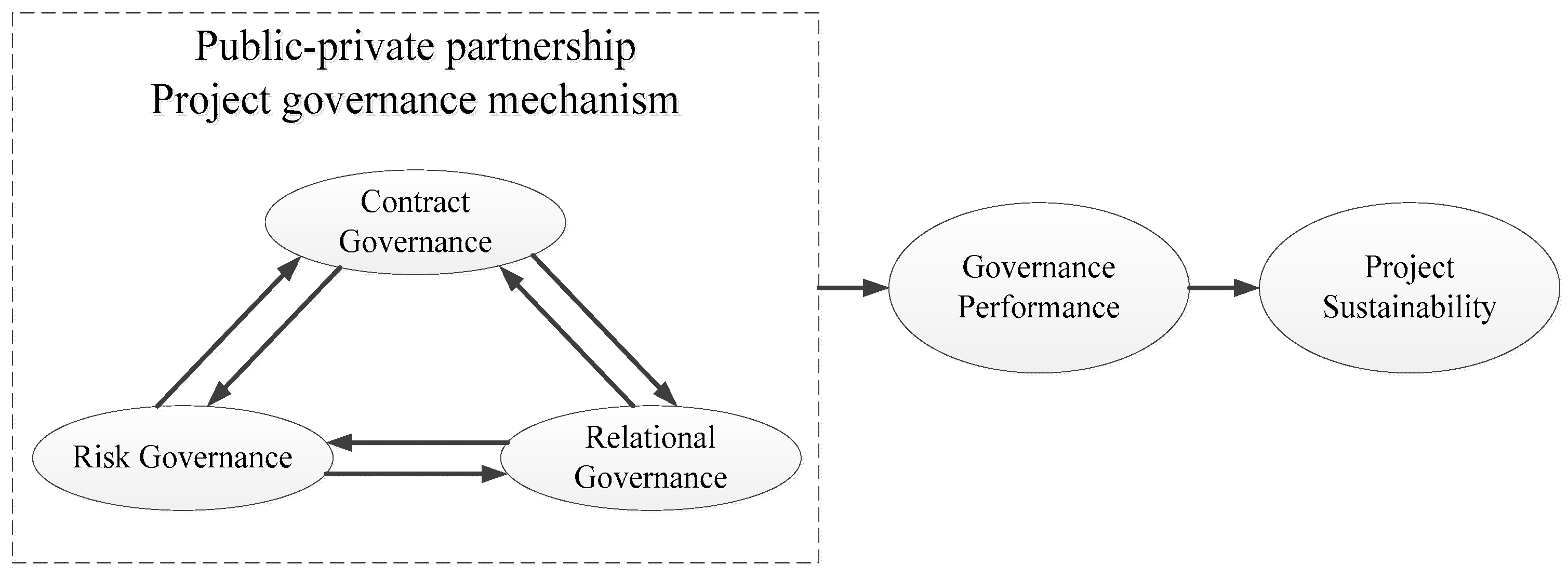

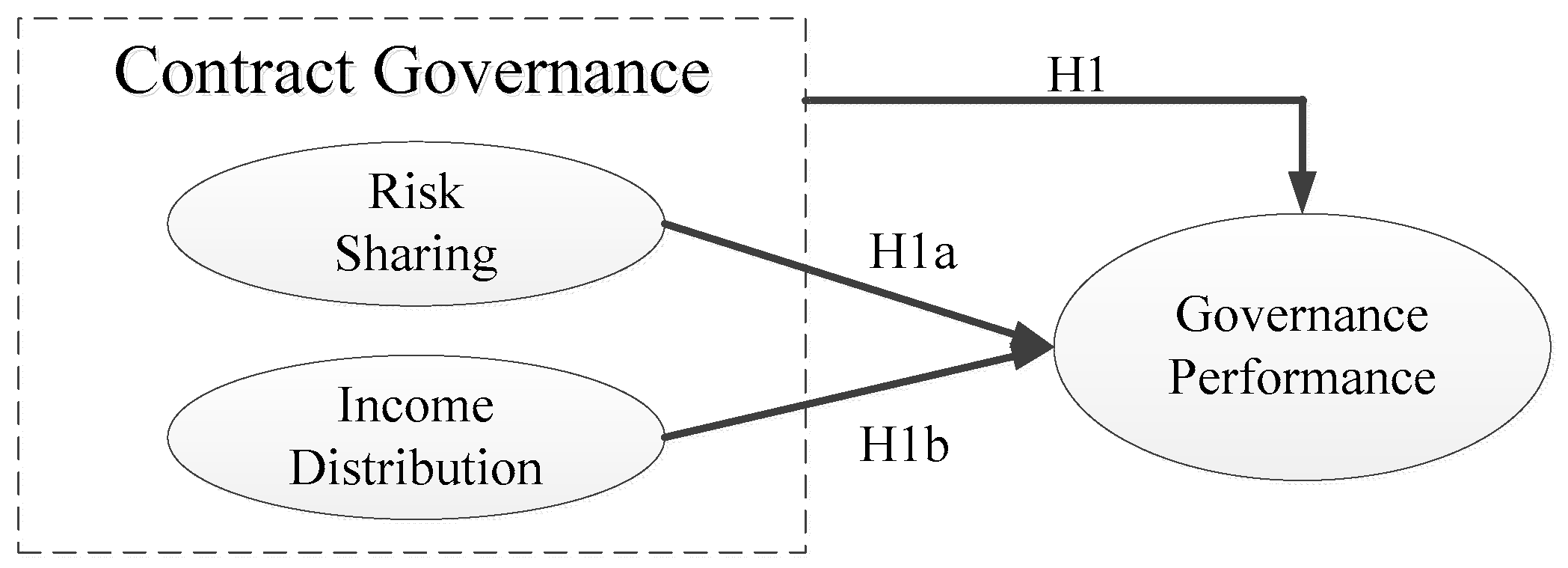

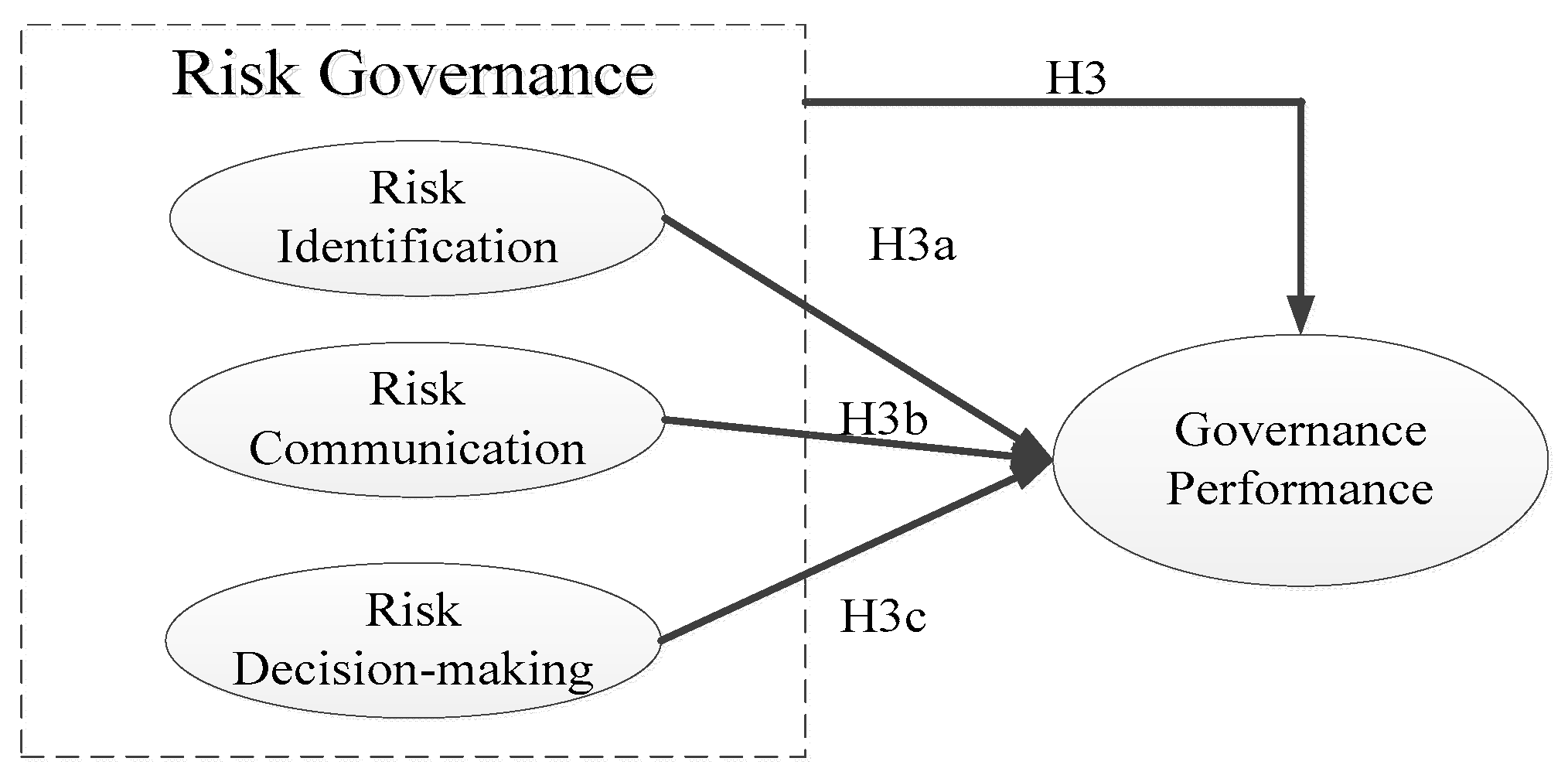


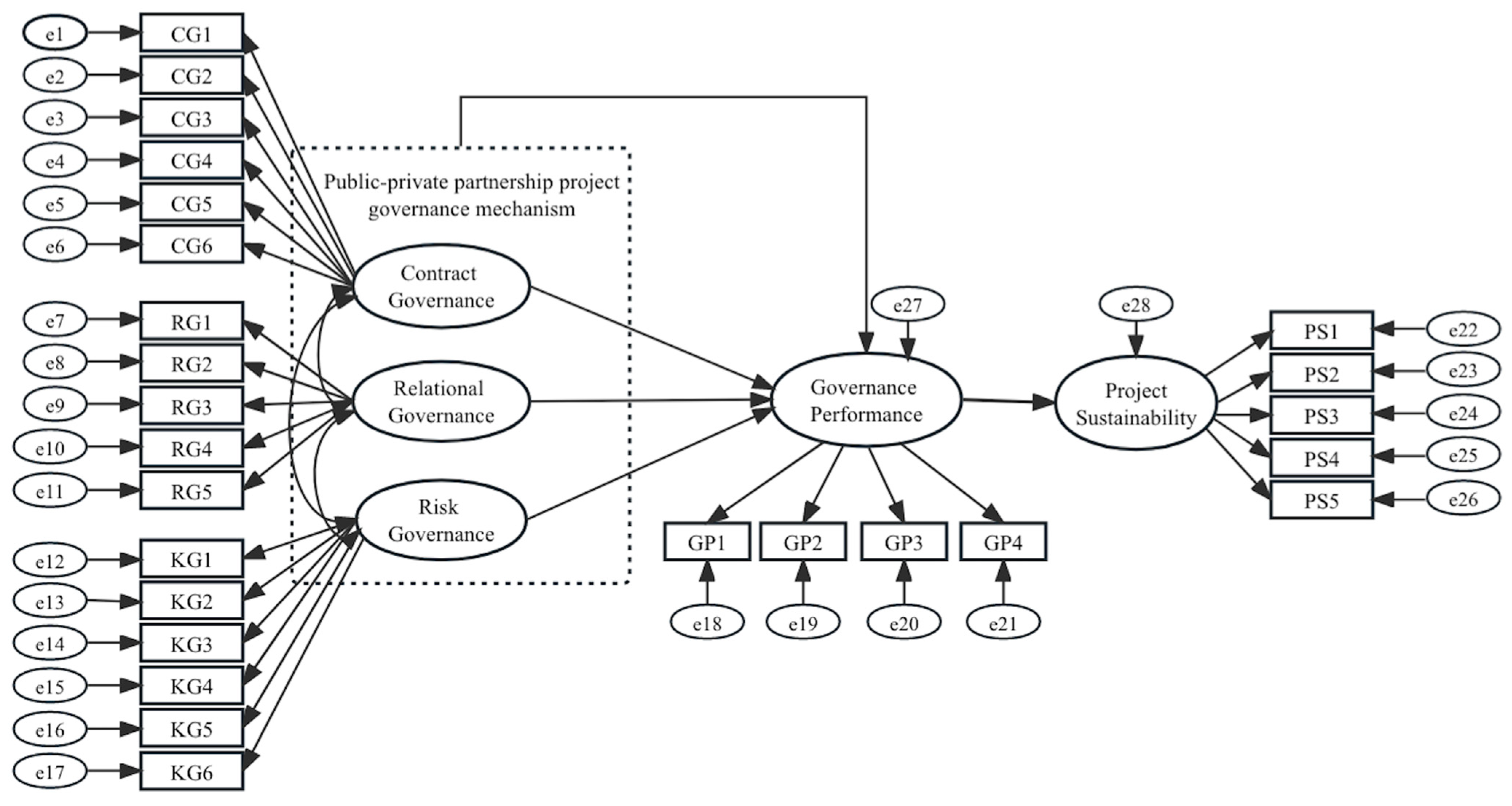
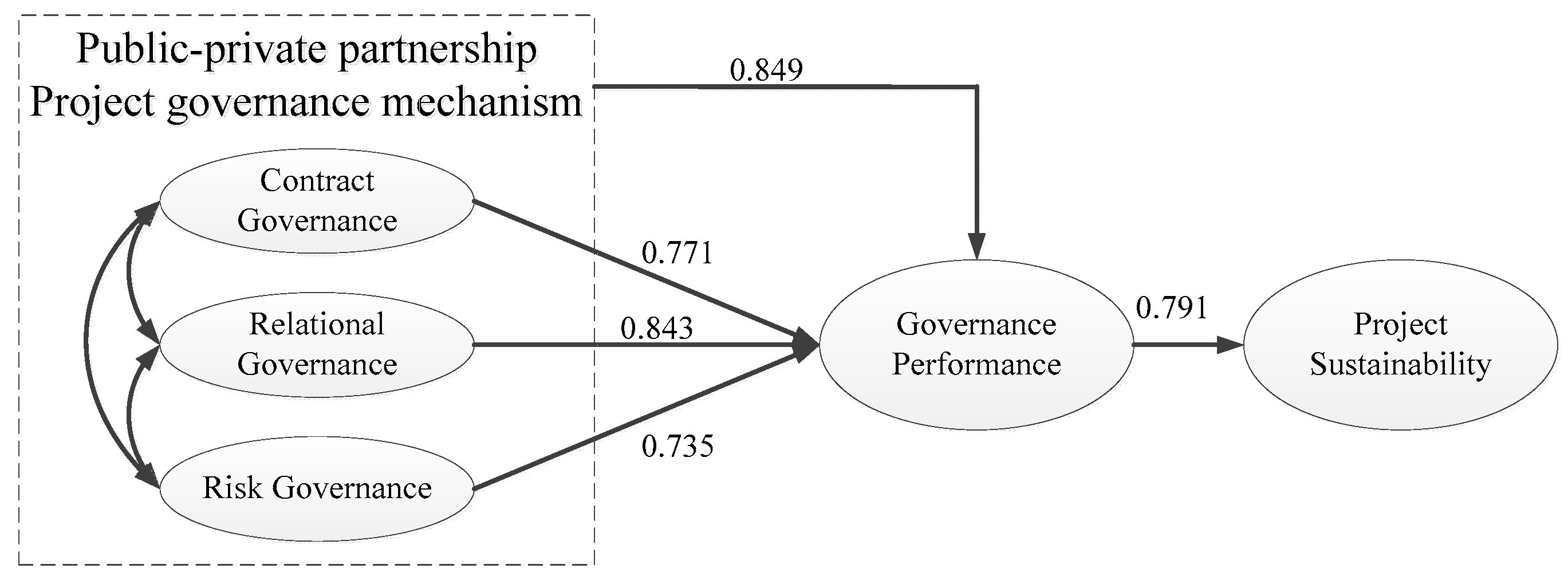
| Related | Action Path | Relationship Properties |
|---|---|---|
| Project governance and governance performance | H0: Project governance → Governance performance | + |
| Contract governance and governance performance | H1: Contract governance → Governance performance | + |
| H1a: Risk sharing → Governance performance | + | |
| H1b: Income distribution → Governance performance | + | |
| Relational governance and governance performance | H2: Relational governance → Governance performance | + |
| H2a: Relationship maintenance → Governance performance | + | |
| H2b: Cultural construction → Governance performance | + | |
| Risk governance and governance performance | H3: Risk governance → Governance performance | + |
| H3a: Risk identification → Governance performance | + | |
| H3b: Risk communication → Governance performance | + | |
| H3c: Risk decision-making → Governance performance | + | |
| Three types of governance mechanism to each other | H4: Contract governance, relational governance and risk governance play an intermediary role in the correlation of other governance to governance performance | Mediatory |
| Governance performance and project sustainability | H5: Governance Performance → Project sustainability | + |
| Constructs | Measurement Items | References |
|---|---|---|
| Contract Governance (CG) | CG1: The duties and rights in the contract are fully set up | SCHEPKER et al. (2014) [28] Sun, Y.G. (2021) [47] Yan et al. (2016) [67] |
| CG2: The contract imposes strict penalties for failure to perform | ||
| CG3: The contract sets up flexible and efficient renegotiation procedures such as changes and price adjustments | ||
| CG4: The contract sets up a clear system of income distribution | ||
| CG5: The contract sets out specific ways to obtain income | ||
| CG6: The contract establishes a price readjustment mechanism | ||
| Relational Governance (RG) | RG1: The partners keep their commitments to us and act as expected | Cao and Lumineau (2015) [16] Li X.G. (2019) [41] Ness & Haugland (2005) [48] Mohr and Spekman (1994) [68] |
| RG2: The partners have been fair in their negotiations with us | ||
| RG3: Our communication with the partners is timely, complete and accurate | ||
| RG4: The partners are willing to share their proprietary information | ||
| RG5: The partners are committed to improving the relationship as a whole, not just individually | ||
| Risk Governance (KG) | KG1: We have a strong sense of risk management | Sun, (2021) [21] M. Haellgren, T.L. Wilson (2008) [48] R. Ortwin, K. Andreas et al. (2011) [69] |
| KG2: We can quickly identify the sources of risk that affect the smooth implementation of the project | ||
| KG3: We value risk communication with our partners | ||
| KG4: Risk communication plays an important role in risk identification and risk decision-making | ||
| KG5: The project has a complete risk assessment system | ||
| KG6: We can make correct judgments about the treatment of risk factors | ||
| Governance Performance (GP) | GP1: Stakeholder cooperation has a high degree of satisfaction | Henisz W, Richardscott W. (2012) [15] She L, Tang S. (2017) [70] |
| GP2: The public has a high degree of satisfaction with the public products | ||
| GP3: The progress, cost and quality of the project are within the control target range | ||
| GP4: The investment income of the project has reached the expected target | ||
| Project Sustainability (PS) | PS1: The project has a low whole life cost | Shen et al. (2016) [6] Babatunde et al. (2020) [9] |
| PS2: The project has a high internal rate of return | ||
| PS3: The project can improve the quality of life of local residents | ||
| PS4: The project does not cause water, air or noise pollution | ||
| PS5: The project focuses on energy conservation during the construction and operation stage |
| Item | Categories | Number | Ratio (%) |
|---|---|---|---|
| Education background | Bachelor’s degree or below | 109 | 40.67% |
| Master’s degree | 115 | 42.91% | |
| Doctorate | 44 | 16.42% | |
| Work experience in PPP project | Less than 3 years | 31 | 11.57% |
| 3–5 years | 86 | 32.09% | |
| 6–8 years | 125 | 46.64% | |
| More than 8 years | 26 | 9.70% | |
| Project type | Traffic and transportation | 84 | 31.34% |
| Municipal engineering | 68 | 25.37% | |
| Environmental protection | 32 | 11.94% | |
| Energy power | 29 | 10.82% | |
| Hydraulic engineering | 25 | 9.33% | |
| telecommunication | 20 | 7.46% | |
| Other | 10 | 3.73% | |
| Role in the project | Government agency | 68 | 25.37% |
| Private enterprise | 67 | 25.00% | |
| Construction unit | 102 | 38.06% | |
| Scientific research institution | 31 | 11.57% | |
| Job position | General staff | 51 | 19.03% |
| Grass-roots management | 64 | 23.88% | |
| Middle management | 92 | 34.33% | |
| Senior management | 61 | 22.76% |
| Variable | KMO | Bartlett Spheroid Test Results | ||
|---|---|---|---|---|
| Approximate Chi-Square | df | Sig. | ||
| Contract governance (CG) | 0.886 | 951.40 | 15 | 0.000 |
| Relational governance (RG) | 0.732 | 499.49 | 10 | 0.000 |
| Risk governance (KG) | 0.772 | 288.82 | 6 | 0.000 |
| Governance performance (GP) | 0.833 | 802.81 | 6 | 0.000 |
| Project sustainability (PS) | 0.813 | 670.44 | 10 | 0.000 |
| Variable | CITC | Cronbach’sα | AVE | CR |
|---|---|---|---|---|
| CG | 0.907 | 0.683 | 0.928 | |
| CG1 | 0.671 | |||
| CG2 | 0.754 | |||
| CG3 | 0.782 | |||
| CG4 | 0.785 | |||
| CG5 | 0.769 | |||
| CG6 | 0.695 | |||
| RG | 0.821 | 0.591 | 0.877 | |
| RG1 | 0.486 | |||
| RG2 | 0.643 | |||
| RG3 | 0.640 | |||
| RG4 | 0.681 | |||
| RG5 | 0.626 | |||
| KG | 0.943 | 0.815 | 0.965 | |
| KG1 | 0.830 | |||
| KG2 | 0.847 | |||
| KG3 | 0.831 | |||
| KG4 | 0.822 | |||
| KG5 | 0.868 | |||
| KG6 | 0.857 | |||
| GP | 0.923 | 0.812 | 0.945 | |
| GP1 | 0.840 | |||
| GP2 | 0.853 | |||
| GP3 | 0.760 | |||
| GP4 | 0.832 | |||
| PS | 0.874 | 0.670 | 0.909 | |
| PS1 | 0.665 | |||
| PS2 | 0.709 | |||
| PS3 | 0.776 | |||
| PS4 | 0.686 | |||
| PS5 | 0.709 |
| Variable | 1 | 2 | 3 | 4 | 5 |
|---|---|---|---|---|---|
| 1 Contract governance (CG) | 0.826 | ||||
| 2 Relational governanc (RG) | 0.612 | 0.769 | |||
| 3 Risk governance (KG) | 0.569 | 0.519 | 0.903 | ||
| 4 Governance performance (GP) | 0.530 | 0.437 | 0.260 | 0.901 | |
| 5 Project sustainability (PS) | 0.568 | 0.588 | 0.281 | 0.721 | 0.819 |
| Model Index | Inspection Standard | Value |
|---|---|---|
| χ2/df | 1 < χ2/df < 3 (the limit is 1 < χ2/df < 2) | 1.998 |
| RMR | RMR < 0.05 | 0.032 |
| RMSEA | RMSEA < 0.05 indicates good adaptation RMSEA < 0.08 indicates proper adaptation | 0.038 |
| GFI | GFI > 0.90 (the limit is GFI > 0.80) | 0.952 |
| AGFI | AGFI > 0.90 (the limit is AGFI > 0.80) | 0.922 |
| IFI | IFI > 0.90 | 0.981 |
| TLI | TLI > 0.90 | 0.982 |
| CFI | CFI > 0.90 | 0.975 |
| Action Path | Standardized Path coefficient | p-Value | Test Results |
|---|---|---|---|
| H0: Project governance → Governance performance | 0.849 | *** | Accepted |
| H1: Contract governance → Governance performance | 0.771 | *** | Accepted |
| H1a: Risk sharing → Governance performance | −0.024 | — | Refused |
| H1b: Income distribution → Governance performance | 0.791 | *** | Accepted |
| H2: Relational governance → Governance performance | 0.843 | *** | Accepted |
| H2a: Relationship maintenance → Governance performance | 0.542 | *** | Accepted |
| H2b: Cultural construction → Governance performance | 0.293 | ** | Accepted |
| H3: Risk governance → Governance performance | 0.735 | *** | Accepted |
| H3a: Risk identification → Governance performance | 0.318 | *** | Accepted |
| H3b: Risk communication → Governance performance | 0.410 | *** | Accepted |
| H3c: Risk decision-making → Governance performance | 0.513 | *** | Accepted |
| H5: Governance performance → Project sustainability | 0.791 | *** | Accepted |
| Hypothetical Path | Total Indirect Effects | Indirect Effect | Lower Limit | Upper Limit | p-Value |
|---|---|---|---|---|---|
| CG → GP | 0.219 | 0.139 | 0.306 | *** | |
| CG → KG → GP | 0 | 0.180 | 0.106 | 0.283 | *** |
| CG → RG → GP | 0 | 0.132 | 0.062 | 0.239 | ** |
| KG → GP | 0.207 | 0.186 | 0.394 | *** | |
| KG → CG → GP | 0 | 0.180 | 0.115 | 0.281 | *** |
| KG → RG → GP | 0 | 0.106 | 0.115 | 0.249 | ** |
| RG → GP | 0.150 | 0.063 | 0.256 | ** | |
| RG → KG → GP | 0 | 0.133 | 0.058 | 0.233 | ** |
| RG → CG → GP | 0 | 0.179 | 0.116 | 0.279 | *** |
Disclaimer/Publisher’s Note: The statements, opinions and data contained in all publications are solely those of the individual author(s) and contributor(s) and not of MDPI and/or the editor(s). MDPI and/or the editor(s) disclaim responsibility for any injury to people or property resulting from any ideas, methods, instructions or products referred to in the content. |
© 2023 by the authors. Licensee MDPI, Basel, Switzerland. This article is an open access article distributed under the terms and conditions of the Creative Commons Attribution (CC BY) license (https://creativecommons.org/licenses/by/4.0/).
Share and Cite
Song, Y.; Hao, S. Influence of Project Governance Mechanisms on the Sustainable Development of Public-Private Partnership Projects: An Empirical Study from China. Buildings 2023, 13, 2424. https://doi.org/10.3390/buildings13102424
Song Y, Hao S. Influence of Project Governance Mechanisms on the Sustainable Development of Public-Private Partnership Projects: An Empirical Study from China. Buildings. 2023; 13(10):2424. https://doi.org/10.3390/buildings13102424
Chicago/Turabian StyleSong, Yingqi, and Shengyue Hao. 2023. "Influence of Project Governance Mechanisms on the Sustainable Development of Public-Private Partnership Projects: An Empirical Study from China" Buildings 13, no. 10: 2424. https://doi.org/10.3390/buildings13102424
APA StyleSong, Y., & Hao, S. (2023). Influence of Project Governance Mechanisms on the Sustainable Development of Public-Private Partnership Projects: An Empirical Study from China. Buildings, 13(10), 2424. https://doi.org/10.3390/buildings13102424







